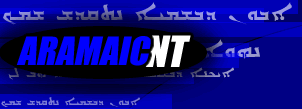|
"Fmxr"
in:
Estrangelo (V1.1) is " " "
(the word "rkhemtha", "friend"
(fem.) ),
CALSyriac is " " "
("rkhém-'F'," the verb "love"
followed by a Roman "F") , and in
Dawod is " " "
("nsmk" no sense at all + wrong forms)!
|
Makes me want to shy away from different fonts that overmap Roman characters,
so on this site, I use Unicode. Instead of having an Alap appear as
the letter A in a font, Unicode allows an Alap to actually be an Alap.
No matter which font you change to, it'll always be an Alap. Each character
(or "glyph") from many, many, many, different languages has
a unique unicode ID number that can be referenced in many types of computer
documents (most importantly of note: HTML). Since I'm using this for
my site, I figured I'd share it with other ancient language enthusiasts,
such as yourself, I presume, so that you can use these in your own documents.
In Unicode, one font takes care of all problems. If you download ONE
unicode-syriac font, you don't need to worry about switching to it,
the computer will do so automatically. If you have more than one unicode
font on your system, the computer will pick which one to display on
it's own, unless told otherwise by the document.
I recommend, for my pages, to download one Unicode font, entitled "Code
2000." It supports all of the character sets I use on this
site (Syriac, Hebrew, and Greek/Coptic) as well as dozens of others
(Chinese, Japanese, Tagalog, etc..etc.) so it's worth the download on
it's own.
Once you have it downloaded and installed, all pages should display
properly, as should all other websites that employ unicode. No more
hastle. :-)
Now, on to the codes!
Syriac/Aramaic:
This is the entire Syriac/Aramaic Unicode sheet. There are two options
for inserting these characters into HTML: Decimal and Hexidecimal. Both
will get you the same result, but Decimal is more widely supported.
The format for the table is as follows:
All you need to do is cut and paste the decimal (top number) or hexidecimal
(bottom number) for HTML documents, or the character itself for Unicode-compliant
word processors.
|
܀
Paragraph Marker
܀
܀
|
ܐ
Alap
ܐ
ܐ
|
ܠ
Lamad
ܠ
ܠ
|
ܰ
Pthaha (above)
ܰ
ܰ
|
݀
Feminine Marker
݀
݀
|
|
܁
Sup-Lin. Stop
܁
܁
|
ܑ
Alap
(Sup-Lin)
ܑ
ܑ
|
ܡ
Mim
ܡ
ܡ
|
ܱ
Pthaha (below)
ܱ
ܱ
|
݁
Qushshaya
݁
݁
|
|
܂
Sub-Lin. Stop
܂
܂
|
ܒ
Beth
ܒ
ܒ
|
ܢ
Nun
ܢ
ܢ
|
ܲ
Pthaha (eastern)
ܲ
ܲ
|
݂
Rukakha
݂
݂
|
|
܃
Sup-Lin. Colon
܃
܃
|
ܓ
Gamal
ܓ
ܓ
|
ܣ
Semkath
ܣ
ܣ
|
ܳ
Zqapha (above)
ܳ
ܳ
|
݃
Two Dots (above)
݃
݃
|
|
܄
Sub-Lin. Colon
܄
܄
|
ܔ
Garshuni Gamal
ܔ
ܔ
|
ܤ
Final Semkath
ܤ
ܤ
|
ܴ
Zqapha (below)
ܴ
ܴ
|
݄
Two Dots (below)
݄
݄
|
|
܅
Horizontal Colon
܅
܅
|
ܕ
Dalat
ܕ
ܕ
|
ܥ
Ayn
ܥ
ܥ
|
ܵ
Zqapha (eastern)
ܵ
ܵ
|
݅
Three Dots (above)
݅
݅
|
|
܆
Left-Skewed Colon
܆
܆
|
ܖ
Dotless Dalat
ܖ
ܖ
|
ܦ
Payn
ܦ
ܦ
|
ܶ
Rbasa (above)
ܶ
ܶ
|
݆
Three Dots (below)
݆
݆
|
|
܇
Right-Skewed Colon
܇
܇
|
ܗ
Heh
ܗ
ܗ
|
ܧ
Backwards Payn
ܧ
ܧ
|
ܷ
Rbasa (below)
ܷ
ܷ
|
݇
Silent Mark (above)
݇
݇
|
|
܈
Left-Skewed Sup-Lin Colon
܈
܈
|
ܘ
Wau
ܘ
ܘ
|
ܨ
Tsade
ܨ
ܨ
|
ܸ
Zlama Pshiqa
ܸ
ܸ
|
݈
Silent Mark (below)
݈
݈
|
|
܉
Right-Skewed Sub-Lin Colon
܉
܉
|
ܙ
Zayn
ܙ
ܙ
|
ܩ
Qop
ܩ
ܩ
|
ܹ
Zlama Qashya
ܹ
ܹ
|
݉
Music Mark
݉
݉
|
|
܊
Contraction
܊
܊
|
ܚ
Khet
ܚ
ܚ
|
ܪ
Rish
ܪ
ܪ
|
ܺ
Hbasa (above)
ܺ
ܺ
|
݊
Barekh
݊
݊
|
|
܋
Harklean Obelus
܋
܋
|
ܛ
Gheth
ܛ
ܛ
|
ܫ
Shin
ܫ
ܫ
|
ܻ
Hbasa (below)
ܻ
ܻ
|
|
|
܌
Harklean Metobelus
܌
܌
|
ܜ
Garshuni Gheth
ܜ
ܜ
|
ܫ
Tau
ܬ
ܬ
|
ܼ
Hbasa (eastern)
ܼ
ܼ
|
|
|
܍
Harklean Astoristicus
܍
܍
|
ܝ
Yud
ܝ
ܝ
|
|
ܽ
Esasa (above)
ܽ
ܽ
|
|
| |
ܞ
Yud-Heh
ܞ
ܞ
|
|
ܾ
Esasa (below)
ܾ
ܾ
|
|
|
Abbreviation
܏
܏
|
ܟ
Kap
ܟ
ܟ
|
|
ܿ
Rwaha
ܿ
ܿ
|
|

